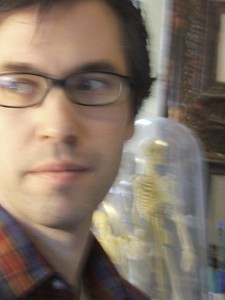 Please help me welcome Adam Rex.
Please help me welcome Adam Rex.
Adam Rex grew up in Phoenix, Arizona, the middle of three children. He was neither the smart one (older brother) or the cute one (younger sister), but he was the one who could draw. He took a lot of art classes as a kid, trying to learn to draw better, and started painting when he was 11. Later he got a BFA from the University of Arizona, and met his physicist wife Marie (who is both the smart and cute one).
His first picture book, THE DIRTY COWBOY by Amy Timberlake, was published by FSG in 2003. His picture book FRANKENSTEIN MAKES A SANDWICH, a collection of stories about monsters and their problems, was a New York Times Bestseller. 2007 saw the release of his first novel, THE TRUE MEANING OF SMEKDAY. His second, a book for teens and adults called FAT VAMPIRE, will be published in July 2010.
Garlic and crosses are useless against Adam. Sunlight has been shown to be at least moderately effective. A silver bullet does the trick. Pretty much any bullet, really.
Q: When did you start illustrating for children? What did you do before?
A: I guess I started illustrating for children when I was a child, though I know that’s not what you’re really asking. But when I was in third or fourth grade, I began to get “commissions” from the other kids. They’d ask me to draw Snoopy, or Yoda, or whatever. I don’t think I got paid or anything–I just drew what they asked because I wanted people to like me. That’s mostly still why I do it.
But in college I started putting together a children’s art portfolio and sending out samples, and maybe in…’97?…I started getting work from magazines like Cricket and Spider. Those jobs led to my first picture book assignment, The Dirty Cowboy, which I landed in 2001.
Before that I paid the bills illustrating for fantasy games like Dungeons & Dragons and Magic: The Gathering.
Q: Wasn’t the Dirty Cowboy recently challenged? Why?
A: Yes, challenged and banned, despite the efforts of a heroic librarian, in a school district in Pennsylvania. I believe the stated reason was “nudity,” which The Dirty Cowboy technically doesn’t contain. In a great letter to the school board, the National Coalition Against Censorship and the ABFFE pointed out that The Dirty Cowboy couldn’t be removed under that rationale alone:
“Otherwise a book about the noted artist Norman Rockwell containing his work No Swimming, which depicts scantily clad bathers, could be removed, along with books about Native Americans or other indigenous cultures, story books about the Bible depicting Adam and Eve or Christ on the Cross, and art history books containing images from Michelangelo’s Sistine Chapel or Botticelli’s Birth of Venus.”
I really appreciated their efforts, but the board voted unanimously to remove it. And yet the whole fiasco caused many, many times more people in that district to view and read the book than would have done otherwise; so while this sort of thing hurts, I’m not so afraid of such a sunlit, public banning. I’m afraid of the others we never hear about.
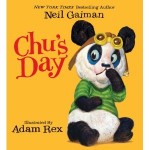 Q: Your newest book released this month is Chu’s Day by Neil Gaiman. Can you share a little bit about the story and how you approached the art for this book? Can you explain your art process?
Q: Your newest book released this month is Chu’s Day by Neil Gaiman. Can you share a little bit about the story and how you approached the art for this book? Can you explain your art process?
A: The first time I heard the story was when Neil read it to me over the phone, and later I was sent both a clean manuscript copy and also Neil’s own doodled dummy. That dummy was unusual–that is, I don’t know if many authors sketch up such a thing, but I do know that it’s rarely shared with the illustrator.
Anyone familiar with his early sketches of Morpheus and Death know that he’s a better than average doodler, but this dummy was nonetheless pretty slight. Which was good–had he really put his all into each drawing, I might have felt obligated to follow it to the letter.
So I started drawing pandas:
I’m trying a little of everything at first, including trying to reduce Chu to his flattest geometrical essence at the bottom. You can also see Merle Lynn, my Merlin character from Cold Cereal, in the corner. This is just a detail from one of my sketchbooks.
Eventually I settled on a little panda I liked, and you can see my earliest drawing of his father, too.
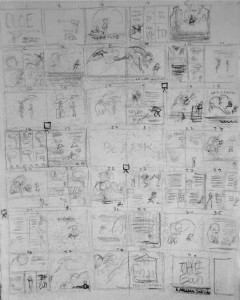

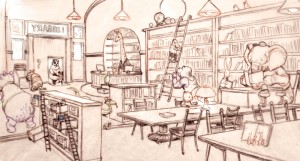


It’s funny that you do your thumbnails on a napkin. Sounds like you’ll draw on anything handy.
Q: What are you working on right now? Do you have any other books or art projects you’d like to talk about?
A: I just finished illustrating the second novel in my middle grade trilogy, The Cold Cereal Saga. And now I’m writing the third. That’s going to keep me busy for a while.
Q: Do you do non-children’s book art (licensing, fine art, etc.) or art just for fun? Is that art similar or different from your children’s book art?
A: Well, as I mentioned earlier, I used to do a tremendous amount of work for games like Dungeons & Dragons and Magic: The Gathering. That was fun, but my preference is to work in kid’s literature so when I no longer needed those fantasy assignments to pay the bills I stopped accepting them. So I haven’t done any of that kind of stuff for years.
Otherwise, I DO occasionally draw or paint something for myself, but that’s pretty rare, I’m afraid. I’m always running behind of some deadline or another, so doing anything just for myself usually feels too self-indulgent. Sometimes I’ll paint or make a little something as a gift for a friend. I like Victorian painting, formal portraiture, Art Nouveau, pretty girls dressed like the anthropomorphic personification of Winter or Industry or whatever, a little bit of pop surrealism…so when I do something for myself or for a gift, it’s usually in that wheelhouse somewhere. Like this portrait of my wife: http://www.adamrex.com/Resources/dawn.jpg
Q: When illustrating children’s books do you include a visual storyline not mentioned by the text or include animals or people you know?
A: Sure, sometimes. It’s often pretty minor–in Chu’s Day, for example, kids can follow the travels of a snail across a number of spreads. Other times it’s not really a storyline, per se, but I might add visual gags that were never asked for by the author, and are never mentioned in the text. Billy Twitters and His Blue Whale Problem has some art-only jokes that I’m proud of.
And a number of my books feature animals or people I know, because friends and family make for cheap art models. I often just shoot myself for photo reference, and my wife gets roped into this a lot as well. My second picture book, Ste-e-e-e-eamboat A-Comin’! (by Jill Esbaum) has more of these kids of cameos than any other I’ve done. I’m in it, my wife’s in it, but also my nieces, siblings, mom and dad, sisters-in-law, cats, friends, cousins, and a number of perfect strangers as well. Just people I met in the neighborhood who didn’t blanch when I told them why I wanted to take their picture. I needed a lot of reference of kids, and I didn’t have any friends with kids at the time, so I was actually reduced to visiting playgrounds and trying to explain myself to moms and nannies. Which is just a terrible, terrible idea. But I eventually got what I needed.
Q: What gets you through an illustration when you’re stuck for inspiration?
A: How do you mean, exactly? Like when I’m struggling with how to compose an illustration, or what style or media to use? I feel like, due to the nature of kid’s narrative illustration, I’m rarely waiting for that flash-of-lightning inspiration that might carry, say, a single editorial image.
Q: Like how to handle an image in a spread or vignette or coming up with the right character for the story?
A: Oh, you know–keeping my eyes open. Sketching and sketching and sketching. Not settling too early. Illustration is problem solving; and I read a quote recently I like, whose originator I can’t remember, that said, essentially: illustration IS the thumbnails, the sketching, the research, the gathering of visual reference, the figuring things out. The finished image is just something you make after you’re done illustrating.
Q: It sounds like you’re always sketching. Do you have a warm-up routine or other habit that helps you stay motivated day in and day out?
A: I actually don’t have anything like that. Maybe I should, to prevent me from disappearing down the Internet hole every morning.
The internet can certainly gobble a lot of time!
Q: Do you have any advice for young illustrators trying to break into the kid lit market?
A: Only put stuff in your portfolio that’s representative of the kind of work you’d like to get. That said, don’t be too self-indulgent. I see a lot of kid’s portfolio pieces that lack any consideration of backgrounds, for example. Or which only contain the illustrator’s very personal and individual flights of fancy, and don’t show that the illustrator is capable of working on anything but their own creator-driven projects. Make sure you have pieces that show kids, and make sure two or more of your pieces contain the same characters, so that you demonstrate that you’re capable of carrying a likeness across multiple images.
And try to only include images that tell a story. Even if they’re stand-alone images, it’ll help if they have some little self-contained narrative.
Q: If you could be anything other than an artist, what would you be?
A: Well, that’s easy. I’d just keep writing. I’s nice to have a Plan B in case my eyes or my hand gives out.



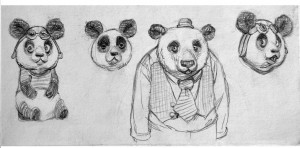
 RSS - Posts
RSS - Posts
What an inspiring interview. I love that Chu came to life on a napkin. It’s also wonderful to see Adam Rex’s process. I’m going to check out The Dirty Cowboy today.